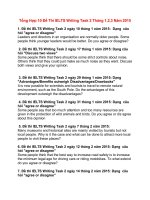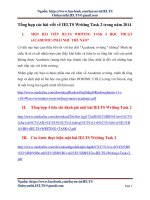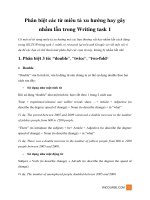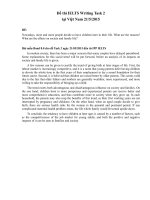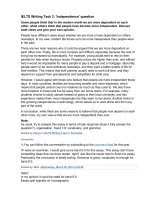Kho ý tưởng writing task 2 (public version)
Bạn đang xem bản rút gọn của tài liệu. Xem và tải ngay bản đầy đủ của tài liệu tại đây (3.04 MB, 63 trang )
MỤC LỤC
LỜI NÓI ĐẦU ...................................................................................................................................................... 6
HƯỚNG DẪN SỬ DỤNG TÀI LIỆU .................................................................................................................. 7
SECTION 1 .......................................................................................................................................................... 8
(PUBLIC VERSION) ............................................................................................................................................ 8
I.
EXTREMELY HARD QUESTIONS........................................................................................................ 10
PRACTICE QUESTIONS ............................................................................................................................................10
Main points ........................................................................................................................................................11
1. One World Government ............................................................................................................................11
2. Competitiveness for Men & Women .........................................................................................................11
3. Crime and Human Nature ........................................................................................................................12
4. Single sex or mixed education ..................................................................................................................12
5. Present or future orientation ....................................................................................................................13
6. An egalitarian society ................................................................................................................................13
II.
BUSINESS .................................................................................................................................................. 15
PRACTICE QUESTIONS ............................................................................................................................................15
Main points ........................................................................................................................................................16
1. Businesses Social Responsibility...............................................................................................................16
2. The Disappearance of Small Businesses ..................................................................................................16
3. Climate Change and Business ..................................................................................................................17
4. Marketing Strategy ....................................................................................................................................17
5. Advertising New Products .........................................................................................................................18
III.
EDUCATION ............................................................................................................................................. 20
PRACTICE QUESTIONS ............................................................................................................................................20
Main point ..........................................................................................................................................................21
1. Free access to university ...........................................................................................................................21
2. Mandatory education ................................................................................................................................21
3. Horticulture and domestication ................................................................................................................22
4. Purpose of education .................................................................................................................................22
5. Food Science .............................................................................................................................................23
IV.
ENTERTAINMENT .............................................................................................................................. 25
PRACTICE QUESTIONS: ...........................................................................................................................................25
Main points ........................................................................................................................................................26
1. Watching Live Events................................................................................................................................26
2. Watching TV and Movies Alone ...............................................................................................................26
3. Dangerous Sports ......................................................................................................................................27
4. Impacts Of Video Games...........................................................................................................................27
5. Independent Filmmakers ..........................................................................................................................28
V.
HEALTH .................................................................................................................................................... 30
PRACTICE QUESTIONS: ...........................................................................................................................................30
Main points ........................................................................................................................................................31
1.
2.
3.
4.
5.
VI.
Public Health Promotion ..........................................................................................................................31
Private Health Services .............................................................................................................................31
Healthy Lifestyle ........................................................................................................................................32
Overconsumption of Soft Drink ................................................................................................................32
Physical Activities in School .....................................................................................................................33
PSYCHOLOGY ..................................................................................................................................... 35
PRACTICE QUESTIONS: ...........................................................................................................................................35
Main points ........................................................................................................................................................36
1. Job Satisfaction .........................................................................................................................................36
2. Changes .....................................................................................................................................................36
3. Definition of Success .................................................................................................................................37
4. Stress in Today’s Society ...........................................................................................................................37
5. Colours and Emotion ................................................................................................................................38
VII.
SPACE ................................................................................................................................................... 40
PRACTICE QUESTIONS ............................................................................................................................................40
Main points ........................................................................................................................................................41
1. Expenditure on Space Exploration ...........................................................................................................41
2. Spending Tax on Space Exploration ........................................................................................................41
3. Life on Other Planets ................................................................................................................................42
4. Space Tourism ...........................................................................................................................................42
VIII.
TOURISM .............................................................................................................................................. 45
PRACTICE QUESTIONS ............................................................................................................................................45
Main points ........................................................................................................................................................46
1. Travel Through Media ..............................................................................................................................46
2. Remote Areas Travelling ...........................................................................................................................46
3. Following Local Customs .........................................................................................................................46
4. Protect Local Culture ................................................................................................................................47
5. Tourism Expansion ...................................................................................................................................47
SECTION 2 ........................................................................................................................................................ 49
(EXCLUSIVE CONTENT FOR IELTS XUAN PHI STUDENTS’ ONLY) ......................................................... 49
I.
ANIMAL SCIENCE .................................................................................................................................. 50
PRACTICE QUESTIONS ............................................................................................................................................50
1. Animal Extinction .....................................................................................................................................50
2. Domestication ............................................................................................................................................50
3. Experiments on Animals ...........................................................................................................................50
4. The Importance of Zoos ............................................................................................................................50
5. Declining Animals .....................................................................................................................................50
II.
ART ............................................................................................................................................................ 51
PRACTICE QUESTIONS ............................................................................................................................................51
1. Public Art ...................................................................................................................................................51
2. Museums and Art Galleries ......................................................................................................................51
3. Government Support for Artists ................................................................................................................51
4.
5.
III.
The Role of Art in Society .........................................................................................................................51
Teaching Art to Children ..........................................................................................................................51
ENVIRONMENT ....................................................................................................................................... 52
PRACTICE QUESTIONS: ...........................................................................................................................................52
1. Plastic Bags ...............................................................................................................................................52
2. Marine Natural Habitats ...........................................................................................................................52
3. Car-Free Days ...........................................................................................................................................52
4. Overpopulation In Cities ...........................................................................................................................52
5. Nuclear Power ...........................................................................................................................................52
IV.
LANGUAGE .......................................................................................................................................... 53
PRACTICE QUESTIONS ............................................................................................................................................53
1. Role of Computer in Language Skills.......................................................................................................53
2. Learning Languages and Customs ...........................................................................................................53
3. An International Language ......................................................................................................................53
4. Golden Age of Learning Language ..........................................................................................................53
5. The Prevalence of English ........................................................................................................................53
V.
LAW AND ORDER ................................................................................................................................... 54
PRACTICE QUESTIONS: ...........................................................................................................................................54
1. Law and Order in Society ..........................................................................................................................54
2. Broadcasted Criminal Trials .....................................................................................................................54
3. Long-term Prison Sentences .....................................................................................................................54
4. Juvenile Delinquency ................................................................................................................................54
5. Gun License ...............................................................................................................................................54
VI.
SOCIAL ISSUES ................................................................................................................................... 55
PRACTICE QUESTIONS: ...........................................................................................................................................55
1. The Meaning behind Traditions ...............................................................................................................55
2. Fulltime working women ..........................................................................................................................55
3. Economic Development and Social Values ..............................................................................................55
4. Financial or Practical Aids .......................................................................................................................55
5. Consumerism in Today’s Society ..............................................................................................................55
6. Relocation To the Cities ............................................................................................................................55
7. Perfect Society ...........................................................................................................................................55
8. The importance of history .........................................................................................................................56
9. The demolition of old buildings ................................................................................................................56
VII.
SPORTS ................................................................................................................................................. 57
PRACTICE QUESTIONS ............................................................................................................................................57
1. Sports and Marketing ................................................................................................................................57
2. Sportspeople as Role Models .....................................................................................................................57
3. Obesity in Population ................................................................................................................................57
4. Banning of Violent Sports .........................................................................................................................57
5. The Role of Sports in Society ....................................................................................................................57
6. Cities and Exercise ....................................................................................................................................57
7. Sports Facilities .........................................................................................................................................57
VIII.
TECHNOLOGY .................................................................................................................................... 58
PRACTICE QUESTIONS: ...........................................................................................................................................58
1. The Internet and School ...........................................................................................................................58
2. Self-Driving Cars ......................................................................................................................................58
3. Artificial Intelligence ................................................................................................................................58
4. Modern Electronics ...................................................................................................................................58
5. Technology and Communication ..............................................................................................................58
IX.
WORK........................................................................................................................................................ 59
PRACTICE QUESTIONS ............................................................................................................................................59
1. Changing Jobs ...........................................................................................................................................59
2. Interviews ..................................................................................................................................................59
3. Societal Contribution ................................................................................................................................59
4. Part-Time Jobs ..........................................................................................................................................59
5. Job Mobility ...............................................................................................................................................59
6. Robots and Jobs.........................................................................................................................................59
7. Retirement age ...........................................................................................................................................59
8. Job Satisfaction/Security ...........................................................................................................................60
9. Human Capital Flight ...............................................................................................................................60
KHÓA HỌC CÁ NHÂN HÓA TẠI IELTS XUÂN PHI .................................................................................... 61
LỜI NÓI ĐẦU
Sau những tháng ngày nghỉ dịch dài đằng đẵng, cuối cùng thì bài thi IELTS cũng đã chính thức
được khởi động lại trên khắp cả nước. Đây cũng chính là thời điểm rất nhiều đề thi Writing Task
2 rất khó được đưa ra, gây ra hoang mang cho rất nhiều người học.
Bởi vậy, IELTS Xuân Phi xin gửi tặng các bạn bộ tài liệu “Tổng Hợp Main Idea cho Writing Task
2. Sách bao gồm 17 topics khác nhau, với tổng cộng 95 câu hỏi IELTS từ dễ tới khó. Mỗi câu hỏi
trong tài liệu sẽ đi kèm với một danh sách ý tưởng và Reference để các bạn tham khảo, từ đó có
thể áp dụng vào bài viết của mình.
Các câu hỏi và ý tưởng đều được chọn lọc một cách kĩ càng, phù hợp với người học. Với mỗi câu
hỏi, chúng mình đều đính kèm các link dẫn tới các Websites mà các bạn có thể tham khảo để dễ
dàng phát triển ý tưởng. Nội dung trên các Website này được viết hoàn toàn bằng tiếng Anh, vì
vậy các bạn có thể thoải mái chọn lọc từ vựng và cấu trúc để áp dụng vào bài của mình.
Writing thực sự là một kỹ năng khó khiến chúng ta thở dài ngao ngán. Vậy nên tâm lý chung của
nhiều bạn mục tiêu band thấp là bỏ qua và dồn tâm sức vào những kỹ năng còn lại với hy vọng vớt
vát được bao nhiêu tốt bấy nhiêu. Nhưng nếu bạn tham vọng mục tiêu cao hơn, hay đơn giản chỉ
muốn có cảm giác thành tựu chinh phục được cả 4 kỹ năng, thì chẳng cịn cách nào khác ngoài
việc Đọc và Luyện tập thật nhiều. Đọc các tài liệu hỗ trợ, bài mẫu IELTS Writing chất lượng;
luyện viết thường xuyên và quan trọng nhất là nhờ ai đó có chun mơn về IELTS sửa bài giúp
mình. Hy vọng IELTS Xuân Phi có thể cùng bước với các bạn trên con đường thốt trầm cảm
Writing.
Chúc các bạn thành cơng!
HƯỚNG DẪN SỬ DỤNG TÀI LIỆU
Tài liệu này sẽ hỗ trợ các bạn lên ý tưởng cho 95 đề bài IELTS Writing Task 2 khác nhau, với các
đề được chia thành 17 Topics. Trong 17 topics này sẽ có 16 topics theo chủ đề, và 1 topic cuối
cùng tổng hợp các “Extremely Hard Questions”.
Trong mỗi topic sẽ có 2 phần, với các thông tin cụ thể như sau:
Phần 1: Practice Questions
Phần này sẽ bao gồm một danh sách từ 4 tới 9 đề bài IELTS Writing Task 2 khác nhau liên quan
tới topic bạn chọn. Các bạn có thể bắt đầu bằng việc đọc danh sách này để chọn đề mình muốn
xem và chuyển qua phần 2 nhé.
Phần 2: Main Points
Phần thứ hai này sẽ bao gồm các đề bài cụ thể, đi kèm với danh sách ý tưởng hỗ trợ, và cuối cùng
là danh sách Reference để các bạn tham khảo.
Cách học:
Bước 1: Các bạn sử dụng mục lục để lựa chọn topic mà mình muốn xem trong tổng cộng 17 topic.
Bước 2: Các bạn lựa chọn đề bài mình muốn xem trong topic đó bằng cách đọc danh sách đề trong
phần “Practice Questions”.
Bước 3: Các bạn sang trang tiếp theo để tham khảo danh sách ý tưởng cho mỗi đề. Các ý tưởng
này đã được chia làm các hướng khác nhau để giúp các bạn dễ dàng trả lời câu hỏi của đề.
Bước 4: Các bạn click vào các đường link trong phần Reference để đọc tài liệu tham khảo. Các tài
liệu này đều liên quan trực tiếp tới ý tưởng nêu trong danh sách, vậy nên các bạn hãy đọc kỹ để
hiểu rõ hơn ý tưởng và cách triển khai, đồng thời học thêm các từ vựng và cấu trúc hay.
*Trong trường hợp các bạn không truy cập được vào Link Reference, các bạn hãy thử đổi phần
mềm khác để mở tài liệu như Google Chrome, Microsoft Edge,...
Sau khi thực hiện các bước trên, các bạn sẽ hình thành được quan điểm của bản thân về vấn đề của
đề bài, và cũng sẽ nắm được các ý tưởng cụ thể để triển khai trong bài viết. Kết hợp với các từ
vựng học thuật các bạn học được, các bạn có thể bắt tay vào viết bài ngay cho nóng nhé.
Nếu các bạn muốn học chuyên sâu hơn nữa sau khi viết bài, hãy liên hệ ngay tới IELTS Xuân Phi
để được chữa bài kỹ lưỡng và hỗ trợ một cách “cá nhân hóa” nhé.
SECTION 1
(PUBLIC VERSION)
I.
EXTREMELY HARD QUESTIONS
Practice questions
1. One world government
Some people think that the world should have one government rather than national
governments. Do the advantages outweigh the disadvantages??
2. Competitiveness for Men & Women
Some claim that men are naturally more competitive than women.
To what extent do you agree or disagree?
3. Crime and Human Nature
Scientists believe that by studying behaviour of 3 years old children, people can predict if
that child can become criminals in the future.
To what extent is crime a product of human nature? Is it possible to stop children from
growing to be a criminal?
4. Single sex or mixed education
Some feel that schools should be mixed with both girls and boys attending. Others feel
the genders ought to be separated.
Discuss both views and give your opinion.
5. Present or future orientation
"Tomorrow is the most important thing in our life." However, some people think that the
present time is more important. How important is it for individuals and the country to
think and do something for the future? What is your own opinion?
6. An egalitarian society
In recent years, there has been growing interest in the relationship between equality and
personal achievement. Some people believe that individuals can achieve more in
egalitarian societies. Others believe that high levels of personal achievement are possible
only if individuals are free to succeed or fail according to their individual merits.
What is your view of the relationship between equality and personal success?
Main points
1. One World Government
Some people think that the world should have one government rather than national
governments. Do the advantages outweigh the disadvantages?
Advantages of a global governance
Disadvantages of a global governance
Individuals would benefit from
It might entail the loss of selfstandardised legislation.
determination.
It could encourage member
There is a risk of member nations
countries to contribute collectively
abusing their power to serve their
to solve common problems.
own interests rather than those of
the entire world.
It can facilitate cross-national
travelling as tourists may not have
There may be a loss of individual
to acquire cumbersome travel
cultural identities because of
documents.
homogenization, especially
relating to language.
It could potentially remove
existing conflicts between nations.
REFERENCE:
Could a world government actually work?
World government
It is time to seriously consider the advantages of a world federal government
2. Competitiveness for Men & Women
Some claim that men are naturally more competitive than women.
To what extent do you agree or disagree?
Men are naturally more competitive
Men are genetically more
aggressive than women.
Women can be as competitive as men
Women have inherent biological
duties that are unique to them,
which render them unable to
compete as often as men.
Women simply have different
outlets for their competitive
qualities.
Contemporary society has
witnessed modern women rapidly
progressing in professional and
personal spheres.
REFERENCE:
Why men are more violent than women
Why do some studies show that women are less competitive than men?
Are women really less competitive than men?
3. Crime and Human Nature
Scientists believe that by studying behaviour of 3 years old children, people can predict if
that child can become criminals in the future.
To what extent is crime a product of human nature? Is it possible to stop children from
growing to be a criminal?
Crime is determined by genetics
It is very common for the children
of violent criminals to display
some degree of abnormal
behaviour as children and later in
life.
Human beings may acquire certain
characteristics that are inherited
from parents.
Criminals tend to have aggressive
behaviours when they were
children.
How to stop children from turning to
criminal life
A large proportion of criminal
behaviour can be prevented by a
supportive family environment.
If young individuals receive proper
education, they might develop
their cognition to distinguish from
right to wrong and avoid illegal
activities.
REFERENCE:
Children of organized crime offenders: like father, like child?
When crime is a family affair
How to turn children into criminals
Preventing involvement in crime
4. Single sex or mixed education
Some feel that schools should be mixed with both girls and boys attending. Others feel
the genders ought to be separated.
Discuss both views and give your opinion.
Separate Sex at School
There will be a more suitable
curriculum for students.
A more relaxing environment as
students are not pressured to
impress the opposite sex.
Breaking gender stereotypes.
Mixed Sex at School
Students will get to socialise with
the opposite sex more often,
improving their communication
skills
With both boys and girls being
given the same opportunity at
school, it could potentially bridge
the equality gap.
It can better prepare students for
the real world.
REFERENCE:
Single-sex schools for children – pros and cons that parents should know
Mixed gender classes vs the single gender classes: who wins?
5. Present or future orientation
"Tomorrow is the most important thing in our life." However, some people think that the
present time is more important.
How important is it for individuals and the country to think and do something for the
future? What is your own opinion?
The importance of future preparation
Personal Opinion
Being future-oriented helps
Being present-focused is a
individuals and a nation to handle
precursor to sustainable future
upcoming calamities.
development
Being future-oriented helps
Being present-focused allows
individuals become motivated and
individuals to quickly address the
focused on their goals.
problems at hand.
REFERENCE:
Are you present or future oriented?
Is it better to be future-oriented or present-oriented?
6. An egalitarian society
In recent years, there has been growing interest in the relationship between equality and
personal achievement. Some people believe that individuals can achieve more in
egalitarian societies. Others believe that high levels of personal achievement are possible
only if individuals are free to succeed or fail according to their individual merits.
What is your view of the relationship between equality and personal success?
Directly proportional relationship
Non-proportional Relationship
As equality is upheld, personal
Equality is only one of the factor
success can be increased as people
determining one’s success as
are given equal opportunity to
evident by the limited number of
succeed
successful individuals, despite the
majority of the population being
treated equally.
REFERENCE:
Better for everyone? Egalitarian culture and social wellbeing in europe
How can we create an egalitarian world?
II.
BUSINESS
Practice questions
1. Businesses Social Responsibility
As well as making money, businesses also have a responsibility towards society.
To what extent do you agree or disagree?
2. The Disappearance of Small Businesses
Small businesses are disappearing and being replaced by large multinational companies.
Do the advantages of this outweigh the disadvantages?
3. Climate Change and Business
Some think that climate change reforms will negatively affect business. Others feel they
are an opportunity for businesses.
Discuss both sides and give your own opinion.
4. Marketing Strategy
Large businesses have big budgets for marketing and promotion and, as a result, people
gravitate towards buying their products.
What problems does this cause? What could be done to encourage people to buy local
products?
5. Advertising New Products
In their advertising, businesses nowadays usually emphasise that their products are new
in some way.
Why is this? Do you think it is a positive or negative development?
Main points
1. Businesses Social Responsibility
As well as making money, businesses also have a responsibility towards society.
To what extent do you agree or disagree?
Reasons for greater business
responsibility
Corporate social responsibility can
improve customers' perception of a
brand.
Being socially responsible can
help business attract more
shareholders.
Talents tend to work for a business
with a high level of
Reasons against greater business
responsibility
Businesses should not be
responsible for social issues that
they are not culpable.
Many companies have contributed
to society by comply with tax and
other vital regulations.
Individuals and government
should also share the social
obligation.
REFERENCE:
Why your company should be more socially responsible
The growing importance of social responsibility in business
2. The Disappearance of Small Businesses
Small businesses are disappearing and being replaced by large multinational companies.
Do the advantages of this outweigh the disadvantages?
Advantages of market predominant by
large businesses
The loss in small businesses may
create a disturbance to a large
company’s supply chain.
The disappearance of small
companies can lead to
unemployment rate crisis.
This trend may cause a loss in
national revenues.
Disadvantages of market predominant
by large businesses
At the state level, a host country
might be the beneficiary of
modern technology transfer from
international companies.
These firms, in addition, aid in the
improvement of the local public
infrastructure.
Consumers can enjoy a diverse
range of products and services at
comparative prices.
REFERENCE:
Small businesses are quietly dying by the thousands during the coronavirus
pandemic
American small business disappearing
19 advantages and disadvantages of multinational corporations
3. Climate Change and Business
Some think that climate change reforms will negatively affect business. Others feel they
are an opportunity for businesses.
Discuss both sides and give your own opinion.
Climate change reforms affects
businesses
Businesses may see a surge in
their operational or investment
costs to comply with new
regulations.
Laws to accelerate the transition
towards a low-carbon economy
can cause a ripple effects on the
economy (i.e.: high bank debts)
Such policies will result in further
critical social and political issues.
Climate change reforms as an
opportunity for businesses
Eco-friendly companies can
benefit from their investment in
green technologies.
This is an opportunity for carbonintensive companies to reshape
their business models.
The low-carbon transition is
creating demand for new
sustainable goods and services
worth trillions of dollars across all
sectors.
REFERENCE:
Climate business | business climate
Climate change, new risks and opportunities for businesses
Climate change is an opportunity for business to thrive
Companies are under pressure on climate change and need to do more
4. Marketing Strategy
Large businesses have big budgets for marketing and promotion and, as a result, people
gravitate towards buying their products.
What problems does this cause? What could be done to encourage people to buy local
products?
Effects of business marketing
Product marketing may entice
consumers to buy unnecessary
items.
Marketing can be expensive and
drain profits, especially for smaller
businesses.
Many promoting campaigns are
not effective because of a lack of
further outcome research.
Measures to promote sales
Government can subsidize smallmedium-enterprises through fair
trade reforms.
Awareness campaign can be
introduced to the population so
that they understand the
importance of supporting local
vendors.
This practice might lead to a
The ban on targeted advertising
hypercompetitive market, leading
can be applied.
to the loss of many small local
brands.
REFERENCE:
Top advertising problems today
Advertising makes us unhappy
Eu parliament backs tighter rules on behavioural ads
The disadvantages of target marketing
5. Advertising New Products
In their advertising, businesses nowadays usually emphasise that their products are new
in some way.
Why is this? What are the problems?
Reasons for claiming products are new
Businesses can incentivise
increased consumer demand.
It is a method of customer
education.
This practice can draw customers’
interest in products.
Problems with claiming products are
new
Companies often disseminate
misleading information to
customers.
Their employees may be exposed
to public criticism from customers
if the products unable to match the
unrealistic expectation.
Businesses’ brand image may be
detrimentally affected with
deceptive acts.
REFERENCE:
Tesla's success proves that what america needs is business, business, and more
business
Negative effects of false advertising
Price misleading advertising: effects on trustworthiness toward the source of
information and willingness to buy
III.
EDUCATION
Practice questions
1. Free access to university
Some people believe that everyone has a right to have access to university education and
that governments should make it free for all students no matter what financial
background they have.
To what extent do you agree or disagree?
2. Mandatory education
Some people think that children under 18 years old should receive full-time education.
To what extent do you agree or disagree?
3. Horticulture and domestication
It is suggested that primary children should learn how to grow vegetables and keep
animals.
Do the advantages outweigh the disadvantages?
4. Purpose of education
Some people believe the purpose of education should be helping the individual to become
useful for society, while others believe it should help individuals to achieve their
ambitions.
Discuss both sides and give your opinion.
5. Food science
Some people think students should study the science of food and how to prepare it.
Others think students should spend time on other important subjects.
Discuss both views and give your opinion.
Main point
1. Free access to university
Some people believe that everyone has a right to have access to university education and
that governments should make it free for all students no matter what financial
background they have.
To what extent do you agree or disagree?
An exemption of tuition fees
Problems with an exemption of tuition
fees
This practice may create a hypercompetitive labour market.
Students study college for free
may put a strain on the state
treasury.
Students may not pay attention to
academic results and study
because it will cost them nothing
to re-take a subject.
An exemption to tuition fees
means that people from lower
socioeconomic backgrounds can
have a chance to pursue higher
education.
At the state level, society will
benefit from a high level of
civilised citizens.
Crime rate can reduce significantly
as people can distinguish between
right and wrong.
REFERENCE:
Free college education today, innovation tomorrow
31 important pros & cons of free college education
2. Mandatory education
Some people think that children under 18 years old should receive full-time education.
To what extent do you agree or disagree?
Reasons for compulsory full-time
education
It is impossible in remote areas,
particularly in developing nations.
In many third-world countries, the
subsidization for education is low.
Many parents prefer homeschooling because they believe
that their children can benefit from
one-on-one attention.
REFERENCE:
Why parents choose home schooling
Rural and remote education
Reasons against compulsory full-time
education
It will form a foundation for
children’ s future orientation.
Education can reduce the rate of
juvenile delinquency.
Education can bring significant
economic returns for a country and
helps societies to achieve lasting
peace and sustainable
development.
Right to education
3. Horticulture and domestication
It is suggested that primary children should learn how to grow vegetables and keep
animals.
Do the advantages outweigh the disadvantages?
Advantages of horticulture and animal
Disadvantages of horticulture and
domestication
animal domestication
Cultivation and animal husbandry
Children might be susceptible to
may develop greater children’s
certain potentially infectious
social awareness which will be
diseases.
crucial for them later in life.
Schoolchildren might injure
themselves with farming tools.
These activities play an important
role in encouraging students to
Many inner-city schools do not
participate in physical exercises.
have easy access to farms.
This practice can equip minors
with a foundation of agricultural
knowledge.
REFERENCE:
Ask a farmer: why is it important to introduce children to agriculture?
Child safety on farms
4. Purpose of education
Some people believe the purpose of education should be helping the individual to become
useful for society, while others believe it should help individuals to achieve their
ambitions.
Discuss both sides and give your opinion.
Becoming useful for society
Students will someday be a part of
a community and need the skills to
exist within that society as
thoughtful citizens.
Education can give people
opportunities to transfer their
knowledge to others.
Without education, a society
would dissolve, no matter the
quality of its constituents.
REFERENCE:
Achieve personal goals
Equipping young people with the
knowledge and skills they need to
secure a place at a good university.
An education can open pathways
to new opportunities, both
occupational and social.
Different people will have
different targets in their life.
An introduction to equality of opportunity
The purpose of education
5. Food Science
Some people think students should study the science of food and how to prepare it.
Others think students should spend time on other important subjects.
Discuss both views and give your opinion.
Study of food science and preparation
Other important subjects
Insightful knowledge into food
The core disciplines standard at
making can exert many benefits in
most schools are imperative for
terms of improved well-being.
one’s future career.
Possessing a solid understanding
School curricula are already
of food and cooking can ensure
notoriously hectic.
not only general well-being but
Students can study food
also serve as a basic survival skill.
preparation in their own time.
It is a prerequisite for students to
prepare for their adulthood so that
they can live independently.
REFERENCE:
Five reasons to study food science
Why you should study food science and nutrition
IV.
ENTERTAINMENT
Practice questions:
1. Watching Live Events
Watching a live performance such as a play, concert, or sporting event is more enjoyable
than watching the same event on television.
To what extent do you agree or disagree with this statement?
2. Watching TV and Movies Alone
People these days watch TV, films, and other programmes alone rather than with other
people.
Do the advantages of this development outweigh the disadvantages?
3. Dangerous Sports
Some people think that governments should ban dangerous sports, while others think
people should have freedom to do any sports or activity.
Discuss both views and give your own opinion.
4. Impacts Of Video Games
Today many children spend a lot of time playing video games and little time on sports.
What are negative impacts of playing computer games and what can be done to minimize
the bad effects?
5. Independent Filmmakers
Films were produced by big companies in the past, but today people are able to make a
film.
Is this a negative or positive development?



